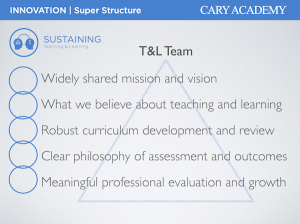It is written on nearly every hallway and classroom; our Discovery Magazine highlights how it comes to life, and any Cary Academy employee, student, or alumni can recite it full or shorthand form:
“The mission of Cary Academy is to be a learning community dedicated to discovery, innovation, collaboration, and excellence.”
Of course, these are merely words unless we have a shared understanding of what they mean for our school. During last year’s strategic planning process, we took considerable time to revisit how we define these words. We found ourselves coming back time and time again to the word “excellence.” We asked ourselves some tough questions:
-
What exactly what about this concept is important for us at Cary Academy?
-
What organization doesn’t want to be excellent?
-
What school doesn’t want its students, employees, and alumni to be excellent?
-
How, exactly, does our understanding of excellence differentiate our school?
At the end of that exercise, we re-defined what excellence means for Cary Academy.
Cary Academy recognizes excellence as meaningful growth resulting from dedicated pursuit of individual and shared goals.
This view is not meant to discount what might be traditional measures of excellence such as our number of National Merit finalists or state championships in Cross Country. Instead, we want to dig deeper, to recognize how excellence is defined by individuals or groups depending on a host of factors.
In her August 24, 2015 article in Harvard Education Magazine, Lory Hough writes about the dangers of using “averages” to define excellence in student achievement. The design of school, says Harvard professor Todd Rose, is built around a mythical “average student,” with the result being that systems, textbooks and curriculum don’t fit about 80% of the students sitting in the classrooms — we end up treating students in one-dimensional terms.
“Imagine two young students have the same IQ score of 110,” writes Hough. “One has great spatial abilities but poor working memory, and the other has the exact opposite.” To rank them by IQ means they are the same, but if we really want to understand them and nurture their potential, we can’t ignore the ways they are different and define different strategies for success.
In thinking about examples outside the classroom, I am often drawn to the world of competitive speech. At a tournament, students compete against each other in rooms of six competitors. They are ranked against each other by a judge, with the best student getting the low score (1) and the worst getting the highest (6). At the end of four rounds of competition, where they speak against a random set of five other students from the full pool, everyone gets an aggregate score — low score wins. Two students who get identical scores of 10 could easily view the results very differently, with a novice to the event being ecstatic and a seasoned and successful vet being disappointed. In one way, they both stood at the podium to accept the same award. In another way, the vet would in no way define her tournament as excellent.
At Cary Academy we are dedicated to helping discover and unlock known and unknown potential in all our students. We help them understand standards of individual (or discipline-based) excellence and to develop the self-awareness and skills to achieve realistic goals. We also work to develop the group and social skills necessary to achieve in interdisciplinary, artistic, and athletic endeavors.
In this way, we can say that we are all constantly striving for excellence at Cary Academy. The target is moving, and we are excited to be on the journey.





